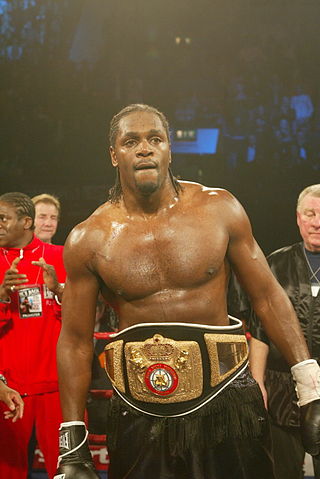
Stanisław Kiecal, better known in the boxing world as Stanley Ketchel, was an American professional boxer who became one of the greatest World Middleweight Champions in history. He was nicknamed "The Michigan Assassin." He was murdered at a ranch in Conway, Missouri, at the age of 24.

Day of the Fight is a 1951 American short-subject documentary film financed and directed by Stanley Kubrick, who based this black-and-white motion picture on a photo feature he shot two years earlier for Look magazine.

Maximilian Adelbert Baer was an American professional boxer and the world heavyweight champion from June 14, 1934, to June 13, 1935. He was known in his time as the Livermore Larupper and Madcap Maxie. Two of his fights were rated Fight of the Year by The Ring magazine. Baer was also a boxing referee, and had occasional roles in film and television. He was the brother of heavyweight boxing contender Buddy Baer and father of actor Max Baer Jr. Baer is rated #22 on The Ring magazine's list of 100 greatest punchers of all time.

Carl "Bobo" Olson was an American boxer. He was the World Middleweight champion between October 1953 and December 1955, the longest reign of any champion in that division during the 1950s. His nickname was based on his younger sister's mispronunciation of "brother".

Audley Hugh Harrison, is a British former professional boxer who competed from 2001 to 2013. As an amateur he represented Great Britain at the 2000 Olympics, winning a gold medal in the super-heavyweight division and becoming the first ever British boxer to win Olympic gold in that division. Harrison turned professional the following year after signing a contract with BBC Sport, and went on to have seventeen fights on the network before their cancellation of all boxing broadcasts.
Randolph Neumann, raised in Cliffside Park, New Jersey, is a former professional boxer who has been a referee for the New York State Athletic Commission since 1982. He has been the "third man" in many championship matches that have taken place in Madison Square Garden in New York City.

William Thomas Wells, better known as Bombardier Billy Wells, was an English heavyweight boxer. Fighting under the name "Bombardier Billy Wells", he was British and British Empire Champion from 1911 until 1919, defending his title fourteen times. In 1911 he became the first Heavyweight to win the Lonsdale Belt, which had been introduced for British champions at all weights in 1909. Phil Grant held his Lonsdale belt when he was in the TA.

John Joseph Killion, more commonly known as Jake Kilrain, was a famous American bare-knuckle fighter and glove boxer of the 1880s.
Albert Finch was a British boxer from Croydon in South London, who was active from 1945 to 1958. He fought as both a middleweight and light-heavyweight, becoming British middleweight champion in 1950.

Lee Savold was an American heavyweight boxer who held the British and European (EBU) version of the World Heavyweight championship between 1950 and 1951 and was a leading contender in the 1940s and early 1950s. During his career he fought storied Heavyweight Champions Joe Louis and Rocky Marciano. Savold was inducted into the Minnesota Boxing Hall of Fame in 2012.

Ronnie Clayton was a British boxer, born in Blackpool, Lancashire whose career highlight was winning the British Empire and European featherweight titles in 1947.
Lionel "Dick" Turpin was an English middleweight boxer. He was British and Commonwealth middleweight champion, reputedly being the first black fighter to win a British boxing title. He was elder brother and trainer of the more famous Randolph Turpin, who became world middleweight champion after beating Sugar Ray Robinson in 1951.
Lee Swaby is a British former professional boxer who competed from 1997 to 2010. At regional level, he challenged twice for the British cruiserweight title in 2004 and 2006, and once for the Commonwealth cruiserweight title in 2004. He holds a notable win over future world cruiserweight champion Enzo Maccarinelli.
Usman "Uzzy" Ahmed is a British former professional boxer who competed from 2006 to 2016. He challenged once for the British and Commonwealth flyweight titles in 2009.
Patrick Taylor Mendy is a Gambian-British professional boxer.

Thomas Glanville Davies was a Welsh Middleweight boxer. Davies was Wales middleweight champion from 1943 until his retirement in 1949. He successfully defended his title on four occasions. Davies was considered a serious contender for the British Middleweight title, but a string of three fights against Vince Hawkins during 1944 robbed him of his chance of a title fight.

Mike "Twin" Sullivan was an American boxer credited with taking the Welterweight Championship of the World on April 23, 1907, when he soundly defeated William "Honey" Mellody in Los Angeles in a twenty-round bout. He vacated the title in the late fall of 1908, when he could not make weight.
Tom Dallas is a British former professional boxer who competed from 2008 to 2017.
Sammy McCarthy was a British professional boxer who was the featherweight champion between 1954 and 1955. He also fought for the British lightweight title and the European and British Empire featherweight titles.
Yolande Pompey was a boxer from Trinidad & Tobago. He beat his fellow countryman "Gentle" Daniel in 1950 and 1951. He lost to Bobby Dawson in 1954. He lost a fight to Archie Moore in a light heavyweight title fight June 5, 1956, at Harringay Arena. He knocked out German champion Gerhard Hecht in 1957. Pompey also fought Dick Tiger and knocked out Randy Turpin. Scottish champion Chic Calderwood was thought to have ended his career with a knockout that sent 29-year-old Pompey to the hospital. He beat Yvon Durelle, Moses Ward, and Dave Sands.











